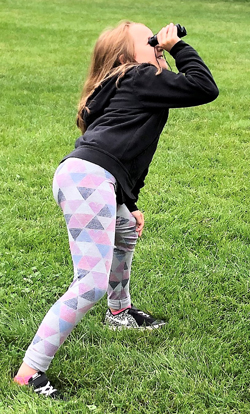“Whoa, things look so close.”
“I can see all the way to the top of that tree.”
“I saw a squirrel once at another park.”
Third graders tried their best to be very quiet while still sharing comments as they explored the Kent City Village Park, looking for squirrels and signs that the woodland creatures could live there. The lesson was to learn how to observe.
Observation is just one of the skills that the students will learn and practice during the first year pilot STEM program at Kent City Elementary.
Beginning this fall, all students – kindergarten through fifth grade – will attend STEM classes as part of the classroom specials, in the same way they leave classrooms for art, music and physical education, said Superintendent Mike Weiler.
Instead of every teacher teaching a science unit, two teachers – Billie Freeland, science teacher, and Nicole Andreas, technology teacher, will instruct all students in the science, technology, engineering and math areas, known on STEM.
New Experiences
“We are so excited about this opportunity for our students,” Principal Pam Thomas said. “STEM will offer them the opportunity to problem solve, collaborate, inquire and express creativity while digging deeper into math and science.”
The move to include all students in activities that inspire critical thinking and problem solving is gaining momentum throughout the district. Last year Andreas taught technology to all age levels on a limited basis. A popular after-school program designed to inspire children from families migrating for seasonal work included exploration with drones and robots.
But now for the first time, the traditional way of teaching science is giving way to these specifically designed STEM classes, which are being taught at every elementary grade.
“In today’s world, all students need a strong STEM foundation,” Weiler said. “This is a way we can help prepare our students for the future.”
Andreas and Freeland continue to train with the Multiple Literacies in Project-Based Learning project, through Michigan State University. The initiative aims to improve literacy and science instruction, Freeland said. Specifically, it is a $5.5 million research project funded by the George Lucas Education Foundation that focuses on learning the complex scientific ideas that align to the Next Generation Science Standards.
“We will use real life situations to help our students practice these skills,” Thomas said. “Our hope is to spark some passion for future careers in STEM-related fields.”
CONNECT















